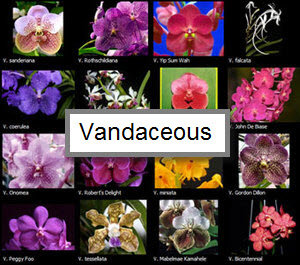Terete-Leaved Orchids are Candidates for Bright Light
ORCHIDS WITH THIN, TAPERING, pencil-shaped leaves that are rounded in cross section have what botanists term terete leaves. This rather unusual style of foliage is found on plants from several branches of the large orchid family.
Among the most familiar of this type are the orchids popularly called terete leaved vandas, typically represented, rather logically, by the species Papilionanthe (syn. Vanda) teres. The genus Papilionanthe includes about 10 terete leaved species that were formerly included in the genus Vanda. Among them is Papilionanthe (syn. Vanda) hookeriana, a species that has been used to create a number of hybrids.
The most famous terete leaved vanda is the hybrid of Papilionanthe teres and Papilionanthe hookeriana. It is known as Papilionanthe (syn. Vanda) Miss Joaquim. The flower was a chance hybrid found in the garden of Agnes Joaquim in 1893. It was described by Henry Ridley, director of the Singapore Botanic Garden, later that year. In 1981, nearly a century after its discovery, Vanda Miss Joaquim was chosen from among some 40 contenders to be the national flower of Singapore.
Culturally, the terete leaved vandas are known as sun lovers. They are often used as landscape plants in tropical climates, where they flower nearly year round. Species in Papilionanthe have been crossed with strap-leaved vandas and ascocendas to produce hybrids with intermediate foliage that is frequently called semi-terete. These hybrids typically sport attractive flowers in an array of candy colors.
A couple of examples quickly come to mind when one considers terete-leaved genera in the Cattleya alliance. One of them is quite familiar, the other perhaps not. The genus Brassavola is well known to most every orchid grower, and Brassavola nodosa would surely be considered its most popular species. Everyone seems to enjoy this orchid. Its terete foliage forms a compact plant that is of easy culture. The creamy white flowers are charming in shape, with thin spidery segments surrounding a flaring spoon-shaped lip. The orchid’s common name, lady of the night, is derived from its sweet nocturnal fragrance. Orchid growers would treasure this flower even if it blossomed but once a year, yet mature B. nodosa plants flower freely and are often in bloom.
There are about 30 species in the genus Brassavola, all with more or less terete foliage. Brassavola subulifolia (syn. cordata) and Brassavola cucullata are two of the more popular and frequently cultivated ones. The primary hybrid Brassavola Little Stars (nodosa × subulifolia [syn. cordata]) can develop into an astoundingly floriferous specimen plant.
Brassavola species and hybrids generally need bright light. High light tolerance is usually associated with most terete leaved plants. Many of them also seem to thrive in the warmer temperatures that are frequently associated with the growing situations that tend to provide the bright light they require.
The same is not quite so true for another terete leaved Cattleya alliance orchid, Leptotes bicolor. This mesmerizing miniature produces fragrant white flowers with contrasting lips in shades of rose or purple. The flowers are remarkably large for the size of the plant. The orchid, when in flower, resembles a semi-alba cattleya that has been greatly reduced in size. Perhaps because of its small stature, and consequently its inability to resist the drying forces of heat and sun, most find this plant thrives better with intermediate to cool temperatures plus a bit of shade.
It could surprise some to learn that the Oncidium alliance includes some members that carry terete leaves too. Some of the species that have terete foliage were discovered and described more than two centuries ago, yet they remain rather uncommon in orchid collections. The plants are sometimes called rat tailed oncidiums in reference to their terete foliage. One of them, Trichocentrum (syn. Oncidium) cebolleta, is among the oldest-known oncidiums, and may have been described as early as 1800.
As one might expect, taxonomists were not in concert as to the classification of the terete leaved oncidiums. While their flowers were similar to those of other oncidiums, their foliage was unique. The rat tailed oncidiums were included in a section within the genus Oncidium for many years, but recently several taxonomists labored to include them in a genus of their own. The genus Trichocentrum is now generally accepted as the correct one for these oncidium lookalikes. Trichocentrum teres, Trichocentrum lacerum (syn. stipitatum) and Trichocentrum jonesianum are among the more common terete leaved species. Trichocentrum also includes most of those rigid, thick leaved oncidiums that are often called mule eared oncidiums.
Similar to other terete leaved plants, the rat tailed oncidiums are adapted to withstand hot, dry conditions. Some species in this genus have been likened to cacti in their design, and, indeed, the comparison is not unwarranted. Their terete foliage has a reduced surface area that minimizes moisture loss from transpiration and an outer layer of cutin helps each leaf to retain moisture as well. In cultivation, it is important to provide these orchids with plenty of light and to allow them to dry out between watering.
Orchid foliage is amazingly variable. Some types have large, thin leaves, a common adaptation for shady conditions. Many orchids have leaves that are thickened to help store moisture for the plant. A few orchid oddities, in fact, have no leaves at all. However with the terete leaved orchids, you always get the point.
